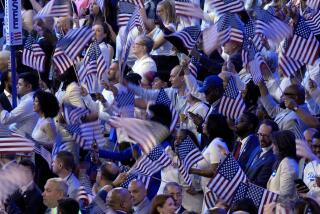Pledging Allegiance Does Not a Patriot Make
- Share via
BERKELEY — Rituals of patriotism have made quite a comeback in the last couple of months. The New York City Board of Education unanimously passed a resolution last month to require all public schools to lead a daily Pledge of Allegiance each morning and at all school events. “It’s a small way to thank the heroes of 9/11,” explained the board’s president. In Orange County, Celebration USA Inc., a nonprofit patriotic organization, synchronized a nationwide recitation of the pledge at 2 p.m. Eastern time on Oct. 12. Several states are considering the adoption of laws that would require the pledge in all public schools, and Nebraska has dusted off a 1949 state law requiring schools to devise curricula aimed at instilling a “love of liberty, justice, democracy and America ... in the hearts and minds of the youth.”
In the aftermath of Sept. 11, people are hungry for social rituals and eager to communicate a deeper sense of national belonging. But this new rash of prescribing and orchestrating patriotism is not the answer.
Rituals of patriotism were first institutionalized between the Civil War and World War I, when organizations such as the Grand Army of the Republic, Women’s Relief Corps and Daughters of the American Revolution campaigned to transform schools, as educator George Balch put it, into a “mighty engine for the inculcation of patriotism.”
Balch, a New York City kindergarten teacher and Civil War veteran, held what is believed to be the first celebration of Flag Day as a way of teaching his mostly immigrant students about the flag. But his was not a patriotism that embraced pluralism. His purpose, as he described it, was to instill discipline and loyalty in what he called the “human scum, cast on our shores by the tidal wave of a vast migration.” He wrote what is considered to be the first pledge to the flag, a clunky manifesto in which students promised to “give our heads and our hearts to God and our Country! One nation! One language! One flag!” In 1890, Balch published a primer for other educators, “Methods for Teaching Patriotism in the Public Schools,” that called for the use of devotional rites of patriotism modeled along the lines of a catechism. “There is nothing which more impresses the youthful mind and excites its emotions,” noted the West Point graduate, than the “observance of form.”
To commemorate the first Columbus Day celebration in 1892, Youth’s Companion magazine asked Francis Bellamy to write a new pledge to be recited by children at school. Bellamy, a Christian socialist with a commitment to social reform, dismissed Balch’s formula as a “childish form of words invented by an ex-military officer.” He wanted a pledge that would resonate with American history and make students into active participants in a “social citizenry.” For Bellamy, the notion of “allegiance” evoked the great call for unity during the Civil War and “one nation, indivisible” recalled a phrase used by Abraham Lincoln. Bellamy was tempted to add the historic slogan of the French Revolution--”Liberty, Equality, Fraternity”--to the language of his pledge, but, in the end, he decided that this would be too much for people to accept. Instead, he settled for the final phrase “with liberty and justice for all.” This way, he reasoned, the pledge could be ideologically “applicable to either an individualistic or a socialistic state,” a matter for future generations to decide.
Bellamy’s words--”I pledge allegiance to my flag and to the republic for which it stands, one nation, indivisible, with liberty and justice for all”--were gradually adopted throughout the country. But the pledge, once imagined as a living principle of justice and liberty, quickly became suffused with militarism and obedience to authority. On Columbus Day 1892, according to newspaper reports, children marched with “drilled precision” as “one army under the sacred flag.”
In the wake of the Spanish-American War, state-sanctioned rituals of patriotism became more common. In New York, soon after war was declared in April of 1898, the legislature instructed the state superintendent of public instruction to prepare “a program providing for a salute to the flag ... at the opening of each day of school.” Daily rituals aimed at reaching children’s hearts were backed up with new civics curriculums to secure their minds with heroic images of virile soldiers and the honor of dying for one’s country. A typical children’s primer published in 1903 taught that “B stood for Battles” and Z for the zeal “that has carried us through/When fighting for justice/With the Red, White and Blue.”
During World War I, worries arose about citizens with dual allegiances, and some feared that Bellamy’s pledge allowed cunning fifth-columnist immigrants to swear a secret loyalty to another country. To close this loophole, the words “my flag” were changed to “the flag of the United States.” Many states now required students to salute the flag every day.
In Chicago in 1916, an 11-year old African American student was arrested because he refused to respect what he saw as a symbol of Jim Crow and lynching. “I am willing to salute the flag,” Hubert Eaves explained, “as the flag salutes me.” Meanwhile, Boy Scout troops across the country staged massive operettas in celebration of “America First.”
Between the world wars, thousands of Jehovah’s Witnesses were persecuted and their children expelled from school for refusing to salute the flag. What began as an attempt to encourage loyalty to a nation “with liberty and justice for all” devolved into the suppression of dissent and unquestioning homage to the flag.
In 1943, the U.S. Supreme Court ruled that an obligatory loyalty oath is unconstitutional, thus putting the law on the side of any student who refused to participate in patriotic or religious rituals. But even after the ruling, refusal to say the pledge took both courage and conviction.
The pledge remained unchanged until Flag Day 1954, when President Eisenhower approved the addition of the constitutionally questionable phrase “under God” to differentiate this country from its godless Cold War antagonist.
Since the Vietnam War and the divides of conscience it generated, educators have not been inclined to impose rote patriotic drills on their students. Instead, schools began slowly to redefine patriotism in a more inclusive way, a way that speaks to the needs of a multiethnic, polyglot population living in an increasingly globalized world. This is not the time to reverse this trend by reverting to form over substance and rote memorization over democratic participation.
“What of our purpose as a nation?” pondered Bellamy more than a century ago when he crafted his pledge. Our students today can better use their time debating this question than marching in lock-step loyalty.
More to Read
Sign up for Essential California
The most important California stories and recommendations in your inbox every morning.
You may occasionally receive promotional content from the Los Angeles Times.










